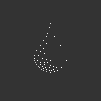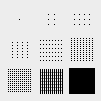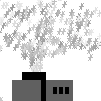 Raindrop
Raindrop
Question 2A: Using the dot drawing
technique described in Chapter 8 of the DBN book, manually position *exactly*
50 dots on your page that look as though they are randomly placed, but
still form a cohesive recognizable image that is non-typographic and non-symbolic.
 Cubist Clock
Cubist Clock
Question 2C: In Passages in Modern
Sculpture (RK) read pp. 0-67. Using DBN, create an image in the cubist
spirit of "The Guitar" (p. 51). You should use at least 5 'command' definitions.
 Geometric Progression
Geometric Progression
Question 3A: Visualize a geometric progression
(GP) of your choice in a concrete manner that emphasizes the wide range
of scales inherent to a GP. This is a simple exercise in Cartesian geometry
that can look as mathy as you like, or not.
 My Line
My Line
Question 3B: Read DD pp. 38 to 66. Using
the basic element of the Line and Dot, construct an image that is evocative
of the intent and spirit of a Line. Define this drawing as a single Command
'MyLine' that you invoke just once.
 Heavy versus Light
Heavy versus Light
Question 4B: Read DD pp. 67 to 103. Create
a dynamic composition of two contrasting elements (i.e. color, shape quality,
movement, etc.) Use comments to explain what you're contrasting.
 Sea Walrus
Sea Walrus
Question 4C: Read RK pp. 147 to 200. Gather
visual elements from at least three of your previous assignments, and create
a 'welded image'. Each of the visual elements should be in a separate Command
(or multiple Commands). Include comments to explain your choices and the
resulting composition.
 Fingerprint
Fingerprint
Question 7B: Create a generally smooth
gradation of white to black, from left to right using only a 100 percent
black pen.
 Look beyond the box
Look beyond the box
Question 9A: Your display is now 200 by
200. Emphasize the difference between your early 100 by 100 display area
and the now larger 200 by 200 display area with a statically motivated
graphic.
 Raindrop
Raindrop
 Cubist Clock
Cubist Clock
 Geometric Progression
Geometric Progression
 My Line
My Line
 Heavy versus Light
Heavy versus Light
 Sea Walrus
Sea Walrus
 Fingerprint
Fingerprint
 Look beyond the box
Look beyond the box